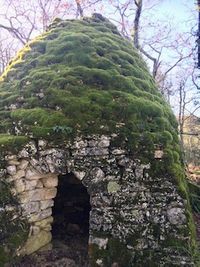Roots of Inspiration - the cultural landscape
One of the oldest place of human civilization in Europe, the plateau des Claparèdes around Saignon has been inhabited since the paleolithic area (200.000 – 35.000 before present).
In antiquity the complex cultural landscape was build by the ancient Celts, Greeks, and Romans who cultivated the landscape, build borries, pagan sites, monuments, farms, temples and churches, and laid the roads, which serve until today as the foundation of later build civilizations. For centuries the northern Celts and the ancient Greek and early Roman civilisations coexisted more or less peaceful in the Provence, which is witnessed by the excavations in Glanum at St.Remy.
In modern times the cultural landscape is layered and contains strata from thousands of years of western civilisation:
- After the great migration of the Vandals, Goths, Saxons, Francs a.o., which lead to the fall of the Roman empire 476, and the time of the dark ages (a term coined by Petrarch that defines the time from 476 until the Renaissance), Provence became a center for Christian spirituality.
- The Cistercian monasteries are most remarkable in the Romanesque simplicity and clarity. Abby Thoronet inspired Le Corbusier to find his clear and strict architectural language, and Abby Senanque, the most picturesque monastery of the three sisters (Abby Silvacane being the third), is an active community of monks. Their services are public, and reduced to Gregorian chants and silent mediation.
- In the 14th century the popes left their mark in Avignon during the great schism. The Provence became the center of Christianity for almost 70 years (1309-1376).
- The ‘good’ King René of Anjou fostered the arts and humanities, brought prosperity and peace to a certain degree during the Renaissance.
- Italian renaissance poet Francesco Petrarca lived in Fontaine de Vaucluse, he is known for his sonnets and the first ‘meditative, spiritual’ climbing of a mountain (Mont Ventoux). He coined the term ‘dark ages’, in which thought to live in.
- Nobel price winner Frédéric Mistral preserved with Mirèio (Mireille) the Provencal language.
- Van Gogh started his studio of light in Arles 1888 and defined what is called today post-impressionism. At the same time Paul Cézanne tackled Mont Sainte-Victoire and redefined the concept of perspective and volume in painting leading the path to cubism.
- Picasso spent many years with Dora Maar in Ménerbes. Here villa is now an artist in residence program of the Huston museum of fine arts. She lived there with Pablo Picasso who later moved to the Château de Vauvenargues.
- Photographer Henri Cartier-Bresson lived in Céreste, he is know for the ‘decisive moment’ in photography.
- In Gordes lived a huge artist community Marc Chagall, Victor Vasarely.
- Albert Camus is buried in Lourmarin,
- Samuel Beckett lived during the time of the French resistance in Rousillion.
- Julio Cortázar, one of the greatest Spanish speaking authors and founder lived in Saignon for many years.
Landscape
The Luberon is a park (Parc Naturel Régional de Luberon) that is classified by the UNESCO as a biosphere reserve. In the valley of the Luberon you find olives, almonds, cherries, apples, wine, vegetables, sunflowers, and lavender. On the south side toward Grass you find one of the most important perfume centres in the world, where the essences of the fragrant plant of the Provence are distilled for the master noses in Paris and perfumes makers all over the world. And the Potager d'un curieux is a farm in Saignon that cultivates seed from rare vegetables and fruits and contributes to the huge diversity of tomatoes, zucchinis, eggplants and herbs, fighting against the extinctions of species.
The lush markets of the Provence are famous for their fresh produce and the delicious little things. The colors, people, smells, sounds, little cafes and bars on the side of the road make these markets most enjoyable and a true treasure hunt for motives and inspiration. There is a market somewhere everyday in one of the beautiful hilltop perched villages. For a more serious treasure hunt you can go to the brocantes and vide-greniers and marché aux puces in L'Isle-sur-la-Sorgue or Carpentras.
But the Provence is also known for the light, smells, walks, music, theater and literature and of course for the French cuisine.
Some of the best wine yards like Châteauneuf-du-Pape in the Côtes du Rhône, Gigondas or Cassis for white wine from Cassis at the Côte d'Azur are just an hour away.
